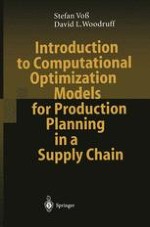The book begins with an easy-to-read introduction to the concepts associated with the creation of optimization models for production planning. These concepts are then applied to well-known planning models, namely mrp and MRP II.
From this foundation, fairly sophisticated models for supply chain management are developed. Another unique feature is that models are developed with an eye toward implementation. In fact, there is a chapter that provides explicit examples of implementation of the basic models using a variety of popular, commercially available modeling languages.
